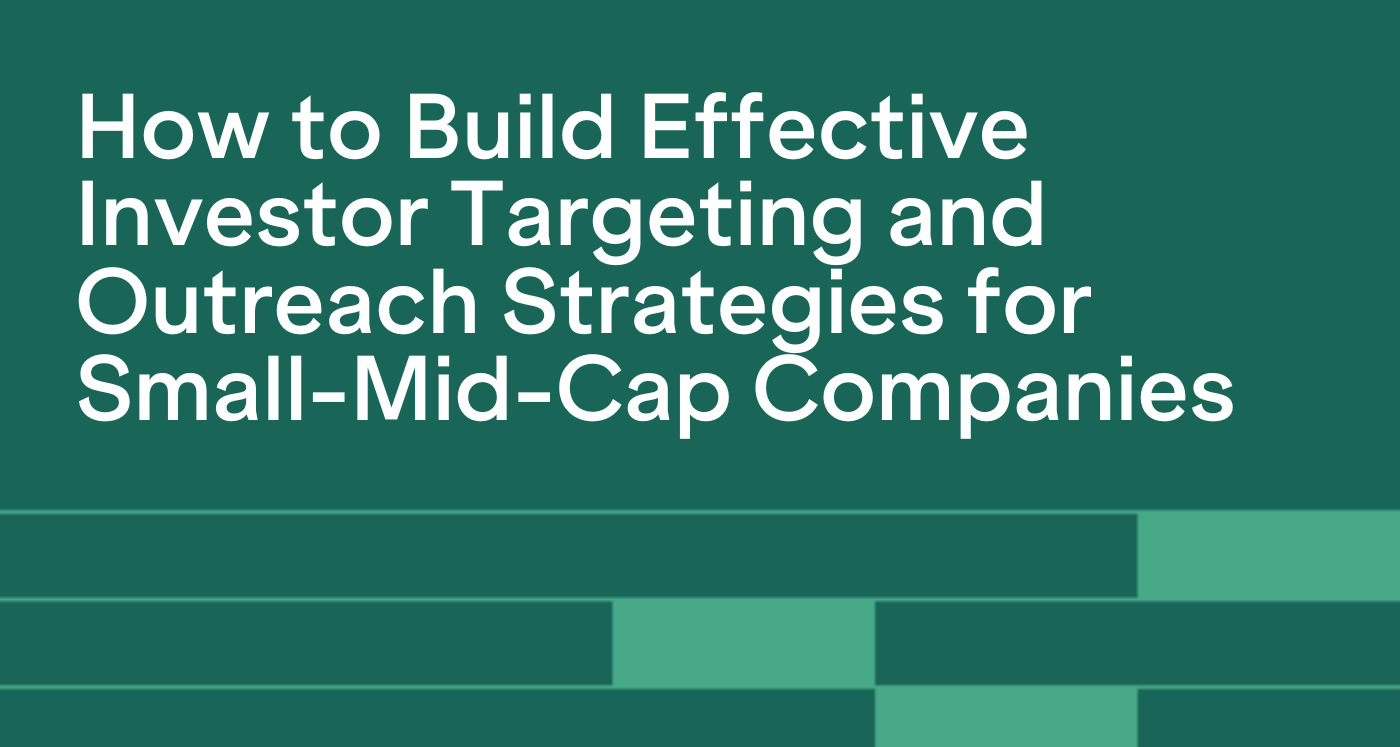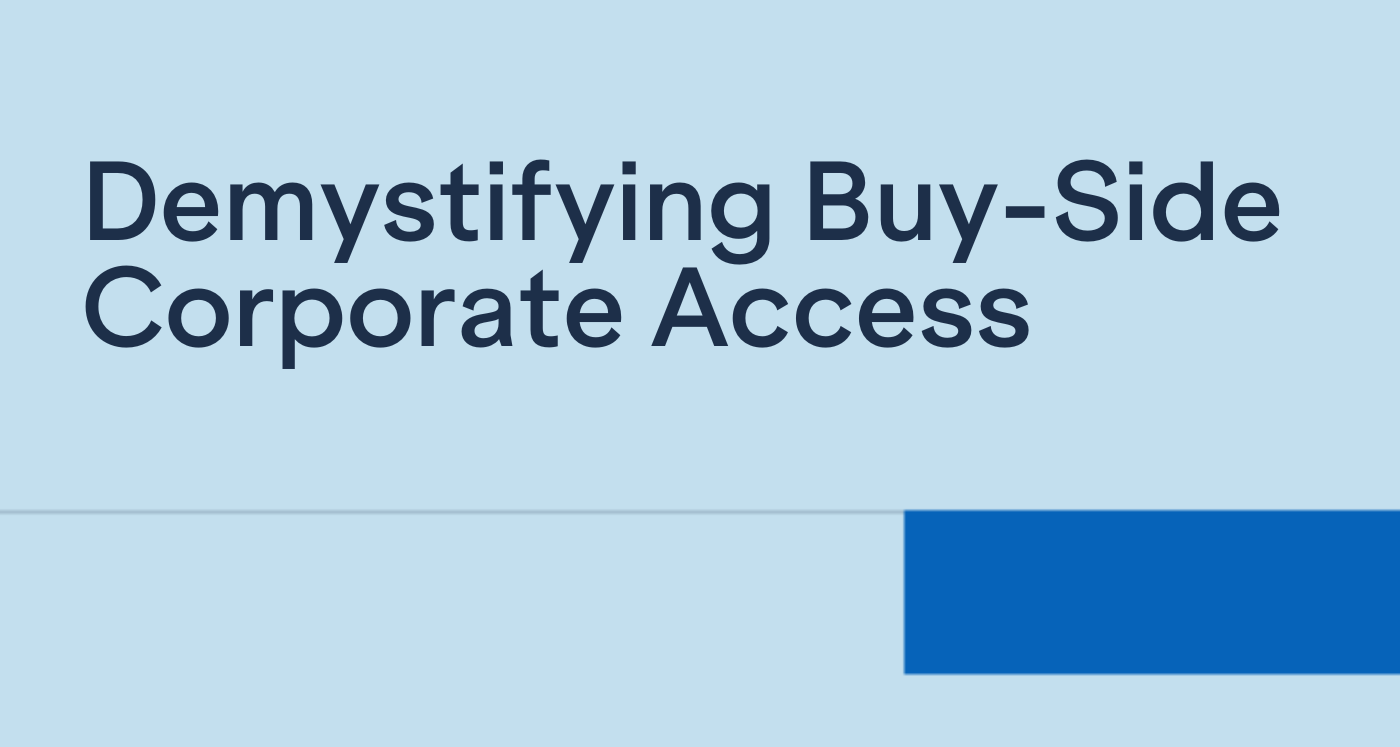
How to Build Effective Investor Targeting and Outreach Strategies for Small-Mid-Cap Companies
Learn how seasoned IR veterans are executing targeting strategies for small-mid-cap companies.

This article is part of our IR Storyteller's Handbook - Download the handbook for a practical guide to crafting and delivering investor communications that resonate.
There are only so many chances to tell your story so it’s critical to make the most of each one. Investor days and earnings calls are two of the most important events for IR teams, offering rare opportunities to reach a broad and deep segment of the investment community. Many IR teams are also going beyond traditional formats with shareholder letters, videos, and other digital content to keep the story fresh and accessible.
Our podcast guests shared how investor days can be one of the most powerful tools for shaping your company’s narrative — when done right.
Hosting an investor day is a great opportunity for you to get your story out and communicate your company’s long-term vision for success. Helene Dina, President and Strategy Partner at HD Strategies, puts it best:
“Investor days are a great opportunity for companies to communicate their strategy, build trust in the management's ability to deliver that strategy, manage expectations for financial outlook, and strengthen relationships with investors and analysts.”
She breaks the purpose down into three clear goals:
Zane Keller, Head of Investor Relations at Affirm, echoes the value of investor days, noting they’re the perfect platform to paint the big picture and share insights you can’t fit into a quarterly earnings call:
“You can really get investors excited about the mission and vision of the company — what it could be in five, 10, even 20 years. Try that on an earnings call, and investors would roll their eyes. Investor days give you the space to lay out that vision and share unique insights across many facets of the business.”
According to Helene Dina, a successful investor day comes down to three core elements:
Your story should be cohesive, easy to follow, and tied to a compelling growth vision. Helene frames it with her three T’s:
“You want to create a clear and consistent equity narrative across the entire event. Those three T’s make it compelling and credible.”
Before you start planning, define your why. What do you want investors to take away? Set realistic expectations internally and externally — investor days are about long-term strategy, not short-term stock price bumps.
“It’s a great opportunity to share your long-term growth strategy and financial outlook — things you don’t get to emphasize on quarterly earnings calls. But don’t think of it as a way to artificially lift your stock in the near term.”
Your speakers are the key to bringing the story to life. Prepare them to communicate clearly, confidently, and persuasively.
“It’s show and tell. State your strategy simply, then use engaging stories and data to illustrate your market opportunity and why your company is uniquely positioned to win. A deep, credible bench of management builds investor confidence.”
Even the best information can fall flat if it’s not delivered persuasively. Helene Dina recommends framing your story as a question your company needs to answer then showing how you’re uniquely positioned to solve it.
She calls this a top-down approach to storytelling:
“Start with the most important point — what your company is going to do — and support it with details. Whether I’m presenting strategy findings, convincing a board, or shaping an investor day narrative, I use the same structure.”
Here’s her framework:
“When you structure your message clearly and logically, it’s much more likely to resonate and stick with investors.”
It’s not just what you say, it’s how you say it. Helene emphasizes that preparation and rehearsal are critical to ensuring your story is delivered with the right tone and confidence.
“Prepare your speakers to be effective storytellers. Rehearse, rehearse, rehearse. Investor day is as much about delivery as content. Get the right resources early — executive coaching, media training, Reg FD training. I tailor coaching to each speaker’s needs so everyone comes across at their best.”
By structuring your story persuasively and preparing your team to deliver it well, you make it easier for investors to believe in your strategy — and in your ability to execute it.
When crafting your story for investor days, don’t forget that you’re addressing a wide range of stakeholders, not just investors. Helene Dina emphasizes that while investors are your primary audience, others like the press, business partners, employees, and even competitors will also be listening.
“I always recommend focusing your content on your target audience — investors — but your overall communication plan should account for other stakeholders, too. Business and trade press, consumer press, employees, retail shareholders, community partners, board members. Even competitors. Work with your communications colleagues to make sure your story resonates across the board.”
She also points out that strong internal relationships are key to making this work. The better your relationships with comms, legal, and other internal teams, the easier it is to keep your narrative aligned and maximize IR’s influence.
“Build those internal partnerships before you need them. They’re essential to delivering a narrative that works for everyone.”
By taking the time to collaborate internally and think beyond investors, you ensure your message lands effectively no matter who’s listening.
After investor day, it’s important to assess whether your story landed as intended. Helene Dina recommends using both qualitative and quantitative measures to gauge the impact of your event.
Helene suggests starting with a perception study six to nine months before investor day. This gives you a baseline of how investors currently perceive your company, helps you identify gaps to address during the event, and sets you up for meaningful post-event comparison.
Your post-event perception study should evaluate whether your key messages resonated, what gaps remain, and how well analysts are reflecting your story in their research.
“You want to see if research analysts are disseminating your key messages accurately and if investor perceptions have shifted in the way you intended.”
On the quantitative side, Helene recommends tracking long-term price movements and stock rating changes over the next 12 months. These indicators reflect whether investors believe in the story you told — and whether you’re delivering on it.
“Price impact can happen over the next three to four quarters, or even longer depending on your business. Rating changes and longer-term movements often tie back to the key messages you delivered — and how investors see your progress against them.”
She cautions against reading too much into near-term stock price fluctuations, which are often just a reflection of pre-existing expectations or short-term guidance.
“Near-term changes in stock price really reflect what the street already had built into the stock — not how they’re thinking about your long-term story.”
By combining these qualitative and quantitative insights, you can better understand how your investor day shaped perception and where your story still needs work.

When planning your investor day, there are some common mistakes to avoid. Zane Keller warns against muddying your story with too many messages. He recommends keeping your story succinct and having no more than three or four main takeaways that you want to resonate with investors.
“One of the biggest lessons from our investor day was not getting lost in the weeds. Investors should walk away with three or four main points — and a clear understanding of how those translate to financial performance.”
Helene Dina cautions that treating investor days like any other trade show or conference risks compromising your messaging. She cites savvy audiences and and a more dignified atmosphere as a reason speakers need to prepare specifically for the investment community.
“One pitfall is treating investor day like a developer or trade conference — often because that’s what the event team is used to planning. But investor day is different. This audience is savvy, asks insightful questions, and doesn’t show overt enthusiasm for things like product launches. They value a clear, straightforward approach. Speakers who are used to high-energy, call-and-response interactions need to be prepared — the energy here is more reserved and unique.”
Quarterly earnings calls are a powerful way to reinforce your company story. While they may not be the place to unveil big new initiatives or long-term goals, they’re the perfect opportunity to build credibility by showing progress and leaving analysts and investors with a clear, planned takeaway.
Many experts describe earnings calls as a bridge — connecting the commitments you made last quarter with your current results. Tiffany Willis, Senior Vice President of Investor Relations at Starbucks, explains:
“I think of every earnings call as a bridge. What did we communicate last time? Let’s walk people over that bridge from last quarter to this quarter. There’s consistency: last quarter we updated you on A, B, and C — here’s how we’ve delivered, and here’s what’s next.”
Helene Dina adds that this consistency is key to building trust:
“You want to say, ‘We told you we’d do X by this date — and we did.’ Repeating that over time builds credibility. Frequent, transparent communication reassures investors that you’re serious about the goals you’ve set.”
By relating your past promises with your present performance, you are effectively providing proof that your company is trustworthy and accountable. This makes your present storytelling efforts more effective because it demonstrates that your commitments are serious.
Every earnings call is an opportunity to reinforce the key messages you want investors to hear. Instead of reading from the press release, Zane Keller encourages IROs to incorporate one or two key messages into earnings:
“I’m always amazed at how many companies use earnings calls to just read the press release or repeat results — or only do the bare minimum at conferences and investor meetings. Every interaction should leave investors with a new insight. Otherwise, what was the point? If all you’re doing is reciting last quarter’s numbers, give them something more: an insight into your business, an impression of management, or even an industry takeaway.”
Beyond traditional events like investor days and earnings calls, supplemental media can help you tell your story in new ways. One of the biggest advantages? These smaller-scale formats can live on your IR website, allowing investors to engage with your story asynchronously.
Shareholder letters, recorded videos, and other on-demand content give you more opportunities to reach wider audiences and reinforce your narrative between major events.

Many IR professionals are turning to shareholder letters as a way to expand on their story and long-term goals — in ways that don’t always fit into an earnings call. For example, during earnings season Zane Keller recommends posting a shareholder letter with your financial disclosures and using your earnings call to to explore unique insights on that data:
“If you're doing a 20-minute opening script where your CFO or CEO is repeating financial results, that is not a good use of anybody's time. A letter or a presentation is a superior method to convey financial information. It also grants you creative license and freedom to help shape the narrative for that quarter.”
This method allows Zane to reference the financial statements and use them to build upon the themes and key messages he wants to discuss on the earnings call. By presenting the data in a refined way, you are helping analysts cut through the noise and hear the messages you want them to hear.
Deborah Belevan, Vice President of Investor Relations at Duolingo, reflects on her choice to implement a quarterly letter:
“We noticed some of the companies we admire were already doing quarterly shareholder letters, and it struck us as a much more effective way to share management’s commentary alongside results — leaving more time on the earnings webcast for Q&A. We’ve now done nine letters, and they’ve really evolved as we’ve learned what works.
“In the beginning, the CEO section was much longer — we tried to cover every new feature or development. But we quickly realized it’s better to focus only on the most impactful highlights and keep it short. Now, we aim to keep the CEO portion to three pages.
“We also keep the design clean and simple. Analysts and investors consistently tell us they appreciate not having to wade through pages of fluff to get to what matters most.”
Video is also a good option for asynchronous communication with the investment community. Because videos can convey facial expressions, body language, and tone of voice, they can be a powerful tool for companies looking to establish confidence in their storytelling. They are also an excellent medium for helping investors pre-establish a relationship with your management team. Ken Goff, Head of IR at Vimeo, explains:
“Video adds consistency by putting a face to the voice. If you communicate through video regularly, then when investors meet you at a conference, they feel like they already know your exec team. They’ve seen them present, watched them talk about earnings.
“It really augments other communications, provides additional content, and gives investors more opportunities to learn about and engage with the company.”
Many companies post recordings of their earnings calls to their IR website. Shorter, more concise videos are also an option, according to Ken, who suggests that your key takeaways after earnings are viable in a three-minute video.
“We realized, looking at our analytics, was that no one was watching a 30-minute earnings video — most viewers dropped off after about two minutes. So we rethought our approach. Now, instead of trying to replace the earnings call, we publish a shareholder letter and use a short video to augment our quarterly communications.
“That’s gotten much better engagement. A three-minute video gets about two minutes of watch time — far more effective than a 30-minute video no one finishes. We’re continuing to tweak and iterate to make it as valuable as possible.”
Strategic storytelling requires maximizing precious opportunities to build your company narrative through key events and supplemental mediums that extend your reach beyond traditional earnings communications.
Investor Days - Your Premier Platform: Use investor days to communicate long-term vision, showcase leadership depth, and address key investor concerns. Focus on the "Three T's": Total Addressable Market (TAM), Targets, and Tangible proof points. Structure your presentation with a clear situation → challenge → solution → evidence framework, limit yourself to 3–4 key takeaways, and measure impact through pre/post perception studies and long-term performance — not short-term price moves.
Earnings Calls - Bridge Your Narrative: Think of each earnings call as a bridge connecting quarters. Reference previous commitments and demonstrate execution: "We told you we would do X, and we're delivering on it." Provide new insights beyond financial results rather than reading press releases. Use calls to reinforce key messages while building credibility over time.
Supplemental Communications - Extend Your Reach: Use shareholder letters to deliver detailed commentary, freeing earnings calls for strategic discussion. Keep CEO letters concise (no more than 3 pages) and cleanly designed. Add short videos (around 3 minutes) to humanize your team and help investors feel connected to leadership before meeting in person.
Unlock more insights into successful IR storytelling.

Learn how seasoned IR veterans are executing targeting strategies for small-mid-cap companies.

Elizabeth Librizzi breaks down the secrets of buy-side corporate access to help investor relations professionals utilize buy-side firms.

What IROs Need to Know About Taking Companies Public: Insights from award winning investor relations thought leader Catherine Buan.